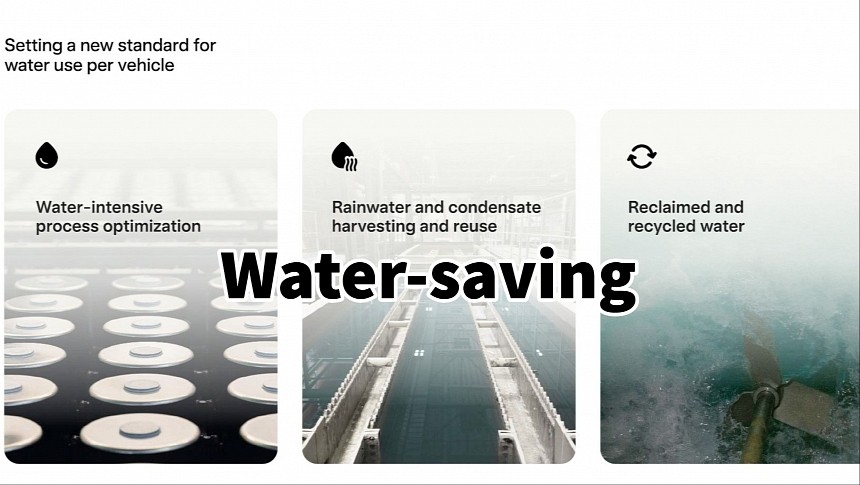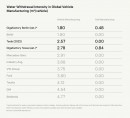Building vehicles is a water-consuming process, with an average of 3.68 cubic meters of water per vehicle produced by the auto industry. Tesla shows in its Impact Report 2022 that Giga Berlin is the most efficient factory in the world based on the water consumed per vehicle. Here is how Tesla managed to achieve this feat.
The auto industry is a significant consumer of freshwater, needing insane quantities of water for vehicle production. The most water-intensive processes in car manufacturing are surface treatment and coating, paint spray booths, washing, rinsing, hosing, and cooling. This doesn't consider car parts manufacturing, which has its own list of water-intensive processes. Even though water use per vehicle in the auto industry has been steadily declining for the past two decades, car factories still need an average of 3.68 cubic meters of water for every vehicle produced.
Tesla is below the car industry average regarding water consumption, thanks to electric vehicles using less water than combustion cars. This is not always true, with water-saving champion BMW using just 1.90 cubic meters of water per vehicle. There are variations even at Tesla, which used an average of 2.57 metric cubes of water per vehicle produced in 2022. This excludes battery production, which needs additional water.
Newer gigafactories don't necessarily fare better, with Giga Texas using 2.78 cubic meters per vehicle produced plus 0.84 cubic meters for the battery pack. The water-saving champion is, as expected, Tesla's Giga Berlin. The never-ending feuds with environmentalists helped Tesla hone its water-saving techniques, achieving an industry record of 1.80 cubic meters per car. The battery pack adds 0.48 cubic meters for a total of 2.28 cubic meters per vehicle, slightly more than BMW but lower than Mercedes-Benz (2.91 m3) and Volkswagen Group (3.75 m3).
The results look even more impressive when you consider Tesla's level of vertical integration. Other carmakers use suppliers for most parts, which means they "outsource" some of their water consumption. On the other hand, Tesla produces most of its components in-house, contributing to overall water consumption. To get these impressive results, Tesla optimizes water-intensive processes and harvests rainwater. It also treats and recycles used water for reuse in manufacturing, minimizing the amount of freshwater needed.
At Giga Berlin, Tesla implemented hybrid cooling towers and eliminated quench tanks in casting. It also introduced cascade rinsing systems in the paint shop and battery can wash process. At Giga Texas, Tesla plans to capture at least 25% of roof runoff in a central underground storage system. Rainwater is recycled for use in the cooling of the manufacturing equipment. The condensed water from the air conditioning is also reused in the cooling towers to offset water consumption.
The biggest contributor to water usage (after painting operations) is the "cooling water makeup." As water that cools machinery evaporates, it needs to be topped up regularly. Tesla uses rainwater and wastewater to offset cooling tower makeup, conserving an estimated 170 million gallons (644,000 cubic meters) of potable water annually. Starting this year, Tesla will also use reclaimed water for landscape irrigation needs, potentially saving additional 150 million gallons (568,000 cubic meters) of potable water annually.
Tesla is below the car industry average regarding water consumption, thanks to electric vehicles using less water than combustion cars. This is not always true, with water-saving champion BMW using just 1.90 cubic meters of water per vehicle. There are variations even at Tesla, which used an average of 2.57 metric cubes of water per vehicle produced in 2022. This excludes battery production, which needs additional water.
Newer gigafactories don't necessarily fare better, with Giga Texas using 2.78 cubic meters per vehicle produced plus 0.84 cubic meters for the battery pack. The water-saving champion is, as expected, Tesla's Giga Berlin. The never-ending feuds with environmentalists helped Tesla hone its water-saving techniques, achieving an industry record of 1.80 cubic meters per car. The battery pack adds 0.48 cubic meters for a total of 2.28 cubic meters per vehicle, slightly more than BMW but lower than Mercedes-Benz (2.91 m3) and Volkswagen Group (3.75 m3).
The results look even more impressive when you consider Tesla's level of vertical integration. Other carmakers use suppliers for most parts, which means they "outsource" some of their water consumption. On the other hand, Tesla produces most of its components in-house, contributing to overall water consumption. To get these impressive results, Tesla optimizes water-intensive processes and harvests rainwater. It also treats and recycles used water for reuse in manufacturing, minimizing the amount of freshwater needed.
At Giga Berlin, Tesla implemented hybrid cooling towers and eliminated quench tanks in casting. It also introduced cascade rinsing systems in the paint shop and battery can wash process. At Giga Texas, Tesla plans to capture at least 25% of roof runoff in a central underground storage system. Rainwater is recycled for use in the cooling of the manufacturing equipment. The condensed water from the air conditioning is also reused in the cooling towers to offset water consumption.
The biggest contributor to water usage (after painting operations) is the "cooling water makeup." As water that cools machinery evaporates, it needs to be topped up regularly. Tesla uses rainwater and wastewater to offset cooling tower makeup, conserving an estimated 170 million gallons (644,000 cubic meters) of potable water annually. Starting this year, Tesla will also use reclaimed water for landscape irrigation needs, potentially saving additional 150 million gallons (568,000 cubic meters) of potable water annually.
Tesla exists to accelerate the transition to sustainable energy.
— Tesla (@Tesla) April 24, 2023
Impact Report 2022 → https://t.co/Zj8onKMJrT
—
2022 Highlights
Last year, our customers avoided releasing about 13.4 million metric tons of CO2e into our atmosphere ????
Tesla vehicle emissions are significantly… pic.twitter.com/2CvMNPGeVh






